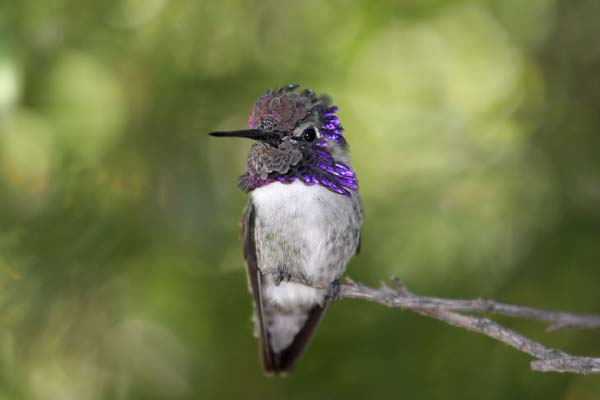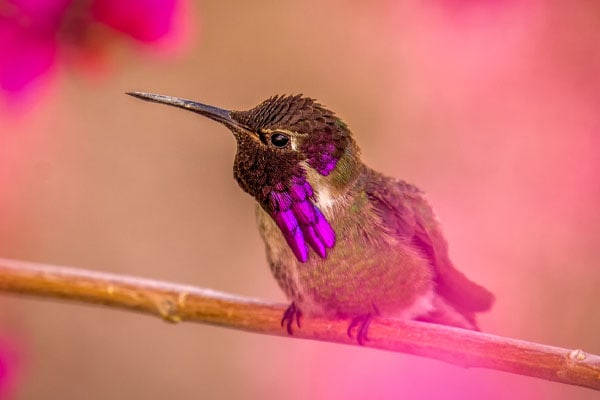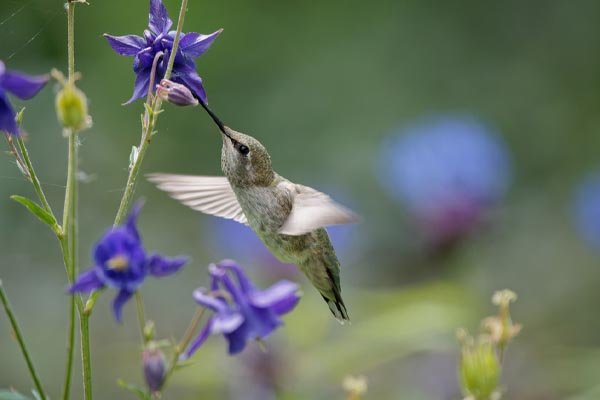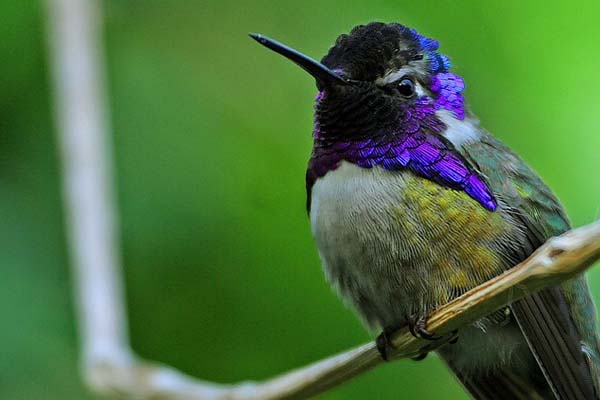Contents
Costa’s hummingbird, also known as Calypte costae, is a beautiful hummingbird species typically found in the southwestern parts of the United States, plus Baja California and Mexico. Many people mistakenly believe these birds are from Costa Rica. In truth, they were named after a French ornithologist named Louis Marie Pantaleon Costa, who was an avid lover of all hummingbirds.
These birds are quite popular and well-known for their unique features, distinctive behaviors, and vibrant colors. One of their most distinctive features is their iridescent plumage. The males have a purple-pink crown and gorget, which shines brilliantly and vibrantly in the sunlight. Females and immatures aren’t as lucky because their plumage is gray-green with white underparts, and it’s much more subdued.
As far as their size is concerned, they are relatively small in stature. They only measure roughly 3.5-4 inches in length, which equates to 9-10 cm. Their bills are long and slender, which is perfectly adapted to extracting nectar very deeply while reaching inside flowers. This nectar is their primary food source, but they also like other protein-rich food sources, including small insects and spiders.
Today, I’d like to share a detailed account with you covering all of the important facts and information about Costa’s hummingbird in greater detail below. Hummingbird lovers will certainly appreciate this valuable information so they can learn much more about these small gifts to mankind. I’ll cover the following topics in greater detail:
- Physical descriptions and character traits of Costa’s Hummingbird
- Costa’s Hummingbird differences between males and females
- Dietary habits, nesting preferences, feeding patterns, and migratory choices of Costa’s hummingbirds
- Other crucial information about Costa’s hummingbirds
Would you like to discover the important facts about these cute diminutive birds? Keep reading to find out everything you ever wanted to know about Costa’s Hummingbird.

Costa’s hummingbird facts
- Common Name: Costa’s Hummingbird
- Scientific Name: Calypte costae
- Scientific Family: Trochilidae
- Life Span: 5-6 years
- Size: 3.5 to 4.0 inches
- Wingspan: 4.7 to 5.1 inches
- Weight: 0.14 to 0.14 oz
- Conservation status: Least Concern
How to identify a Costa’s hummingbird
It’s easier to identify a Costa’s hummingbird than you might think. There are certain behaviors and characteristics they’ll have to pay attention to, to properly make an identification. The key identifying features of this bird species include:
- Size – this is a relatively small bird, as mentioned earlier, since it’s only 3.5-4 inches in total length. It isn’t the smallest Hummingbird, but it’s definitely on the tiny side.
- Shape – Costa’s Hummingbird has a long thin bill and a slender body, which makes it perfectly adapted to drinking nectar deep from within certain flowers. Their bill also curves in a slightly downward direction, and it’s on the longer side when compared to other hummingbirds.
- Tail – the tale of the male Costa’s Hummingbird is deeply forked and quite unique looking. The outer portion of the tail extends out even further than the tail feathers in the lower portion. Their forked tail is very distinct amongst hummingbirds, and it’s very easily noticeable while perched or during flight.
- Flight Patterns – Costa’s Hummingbird flies rapidly and directly, which is very similar to other hummingbirds. And just like other birds, it beats its wings very quickly and has the ability to hover. It’s also capable of flying in any direction, including forward, backward, and side to side. While flying, these birds typically make buzzing and clicking sounds, which is another way to best identify them.
- Unique Vocalization – Costa’s Hummingbird is also known for its distinctive vocalization. In particular, when it vocalizes, it does so by making a series of high-pitched rapid clicks or chips.
Difference between the Male & Female Costa’s hummingbird
There is a slight size difference between male and female Costa’s hummingbirds. In general, the males are larger than females, but only by a slight margin.
When it comes to their plumage, the adult male Costa’s Hummingbird has a striking and vibrant coloration. Their crown and throat are a brilliant purple-pink, and in the sunlight, it becomes very vibrant. As far as the rest of their body is concerned, their body color is mainly grayish-green. Females, on the other hand, have plumage that is much more subdued. They have white underparts and gray-green upper parts and no flashy gorget.
The males have a very distinct tale, which happens to be deeply forked. Females also have a forked tail, but it is much less deeply forked than their male counterparts.
Differences in Summer Plumage vs. Winter Plumage
Female Costa’s hummingbirds, unfortunately, have a mild and subdued plumage throughout the entire year, no matter the season.
On the other hand, males tend to maintain an incredibly vibrant and distinct plumage throughout the entire breeding season. But during the winter non-breeding season, the males will molt, and their plumage changes. The male gorget is no longer the same vibrant purple-pink color that it once was, and it’s a lot less prominent. The coloring becomes more of a muted gray as opposed to the bright pink coloration. The rest of their body doesn’t really change because it maintains its grayish-green hue during the winter and summer months.
Where You’ll See Costa’s hummingbirds

Costa’s Hummingbird is mainly found in the southwestern part of the United States, and it also has a presence in Baja, California, and Mexico. Specifically, these birds love to spend time in arid and semi-arid areas with lots of desert scrub, open woodlands, and low-lying vegetation.
Most commonly, these hummingbirds prefer living in desert oases, areas with flowering plants because of the nectar, and riparian corridors.
When trying to spot Costa’s Hummingbird in the wild, stick to areas with lots of flowering plant life. In particular, you should look for them in areas with lots of tubular-shaped flowers because these are quite attractive to hummingbirds since they like to drink the nectar. You may also find hummingbirds in backyards because they like drinking sugar-water solutions from their feeders.
They live in the following areas:
- Arizona – they love the desert regions of Arizona, in particular in the central and southern parts of the state, in places like the Sonoran Desert, Phoenix, and Tucson.
- California – these birds are often found in certain parts of southern California. They particularly prefer the climate of the Coachella Valley, the Anza-Borrego Desert, and the Mojave Desert.
- Nevada – you can find Costa’s hummingbirds in the southern part of the state.
- Mexico – believe it or not, Costa’s Hummingbird is native to Baja California in Mexico; more specifically, it tends to gravitate to the northern parts of the polenta, including the Sierra de San Pedro Martir National Park and the regions surrounding it.
Costa’s hummingbird migration patterns
In truth, the Costa’s Hummingbird isn’t really considered a migratory bird. They do not travel long distances for seasonal migrations, which is different from other hummingbird species. Instead, they maintain a primary residence and specifically stick to their preferred habitat throughout the year.
Diet and Feeding Preferences
Costa’s hummingbirds primarily like to drink the nectar to acquire calories and energy from flowering plants. But they also eat spiders and other small insects to supplement their diet. Some of their feeding preference details include:
- Nectar – their main energy source comes from nectar, which makes sense because they have long and slender bills and specialized tongues. These specialized features make it easy for them to reach inside deep flowers to quickly and painlessly extract nectar without any difficulty whatsoever. Specifically, they like to get their nectar from tubular-shaped flowers from various cacti, agave, and ocotillo. They’ll even drink man-made nectar in birdfeeders when they come across it.
- Spiders and Other Insects – they enjoy eating spiders and other insects because they provide protein and other nutrients. They can catch their prey in mid-flight because they are quite agile, and they can even hover in midair or pluck them off of vegetation. Most commonly, Costa’s hummingbirds prefer eating spiders, small beetles, flies, and gnats.
- Backyard Bird Feeders – Costa’s hummingbirds aren’t afraid of being around human beings, so they will gladly visit backyard bird feeders whenever they are available. These birdfeeders tend to contain a sugar-water solution that bears a resemblance to the nectar found in their favorite flowers.
Costa’s hummingbird nesting

Costa’s hummingbird nesting
- Clutch Size: 1-3 eggs
- # of Broods: 2 broods
- Incubation Period: 15-17 days
- Nestling period: 21-23 days
- Egg Description: White or Off-White
Costa’s hummingbirds definitely have very interesting nesting behaviors, to say the least. When it comes to constructing their nest, they typically build it with moss, lichens, fine plant down, and other plant fibers. They also use spider silk in an effort to bind the nest materials together, which certainly supports it and helps it stick to the supporting branches. They also like to keep their nest camouflaged with material from the surrounding environment so that it blends in with the area.
Unlike other hummingbirds, Costa’s Hummingbird prefers to keep their nests in low trees or shrubs, not high up in the air. They choose locations near riparian areas, desert oases, or habitats that have suitable resources and vegetation that meet their preferences. But most important of all, the nesting site must provide concealment and protection to keep females and their eggs safe while incubating.
The females are responsible for incubating the eggs. Typically, there are 1-3 eggs in the cup-shaped nest that she’ll sit on for 15-19 days. She will continue to incubate her eggs until they finally hatched.
Parental care is divided among both bird species. Males and females do a great job working together to care for their nestlings. They will take turns guarding and feeding their young ones. During feeding, the parents will regurgitate a mixture of nectar and small insects into their baby bird’s mouth. These nutrients are necessary for their health and development.
The baby nestlings grow very quickly and they actually begin to develop their feathers within a few days. After three weeks or so, they have their full feathers, and they’re just about ready to start fledging. Parents will keep feeding and protecting them during this time.
Finally, unlike many other hummingbirds, Costa’s Hummingbird has multiple broods per season instead of just one. Once the first brood fledges, the female will begin building a new last to lay more eggs.
Costa’s hummingbird behavior
Costa’s hummingbirds display a number of specific behaviors besides their unique ability to fly and their abilities to consume nectar, which we have touched upon.
As far as territorial behavior is concerned, it is the male Costa’s hummingbird’s responsibility to choose and protect their territory throughout the breeding season. Once the territories are established, and flowering plants are in abundance, the male Hummingbird will actively and aggressively defend their territory. He will chase away other hummingbirds trying to encroach upon its territory and other larger bird species as well.
Courtship displays are unique behavior of the male Costa’s Hummingbird as well. He does this in an effort to attract females. The courtship displays include U-shaped flights, rapid dives, and lots of aerial acrobatics. These displays are often accompanied by different vocalizations. The male also likes to flash his beautiful bright purple-pink gorget in order to impress the females.
Males are also known to vocalize while defending their territory. They will elicit vocal warnings to other birds including other hummingbirds. They do this in an effort to keep them at bay and keep their territory and resources protected for their newly growing family.
Conservation Status
The Costa’s Hummingbird is currently given the status of Least Concern. Ultimately, this bird species is not in danger of major population loss or extinction in the near future. They aren’t facing any significant threats to their habitat or health. But monitoring things like habitat loss, climate change, pesticides and pollutants, and conservation efforts certainly doesn’t hurt to maintain a healthy Costa’s Hummingbird population.
Fun & Interesting Facts
- According to researchers, Costa’s hummingbirds are capable of entering a torpid state. This means they can reduce their body temperature and slow their heart rates, which is important because it helps them survive the low temperatures during the night.
- While sleeping, the Hummingbird’s heart rate rests at 50 bpm. While awake, it might be anywhere from 500-900 times per minute.
- The oldest recorded Costa’s Hummingbird was a female. She lived for eight years and nine months.
- Costa’s hummingbirds will drink nectar from a mass abundance of flowers throughout the day in order to meet their energy requirements. In fact, it’s estimated that they visit 1840 flowers to get enough calories for the day, which is quite a lot.
- Although Costa’s hummingbirds prefer living in the Southwest, there have been occasions where they showed up in the Pacific Northwest and have even gone as far as Alaska and British Columbia in Canada.
Explore More Species in This Family
- Ruby-throated Hummingbird (Archilochus colubris)
- Rufous Hummingbird (Selasphorus rufus)
- Broad-tailed Hummingbird (Selasphorus platycercus)
- Costa’s Hummingbird (Calypte costae)
- Allen’s Hummingbird (Selasphorus sasin)
- Black-chinned Hummingbird (Archilochus alexandri)
- Blue-throated Hummingbird (Lampornis clemenciae)
- Calliope Hummingbird (Selasphorus calliope)
- Cinnamon Hummingbird (Amazilia rutila)
- Green-breasted Mango (Anthracothorax prevostii)
- Long-billed Hermit (Phaethornis longirostris)
- Magnificent Hummingbird (Eugenes fulgens)
- Violet Sabrewing (Campylopterus hemileucurus)
- White-necked Jacobin (Florisuga mellivora)
- White-tailed Goldenthroat (Polytmus guainumbi)
- Xantus’s Hummingbird (Hylocharis xantusii)
- Berylline Hummingbird (Amazilia beryllina)
- Violet-crowned Hummingbird (Amazilia violiceps)
- Buff-bellied Hummingbird (Amazilia yucatanensis)
- Snowcap (Microchera albocoronata)
- Long-tailed Sylph (Aglaiocercus kingii)
- Plain-capped Starthroat (Heliomaster constantii)
- Sparkling Violetear (Colibri coruscans)
- Brazilian Ruby (Clytolaema rubricauda)
- Fiery-throated Hummingbird (Panterpe insignis)
- Black-throated Mango (Anthracothorax nigricollis)
- Long-tailed Hummingbird (Rhamphomicron longicauda)
- Purple-crowned Fairy (Heliothryx barroti)
- Green Thorntail (Discosura conversii)
- Violet-headed Hummingbird (Klais guimeti)
- Amethyst Woodstar (Calliphlox amethystina)
- Bronze-tailed Plumeleteer (Chalybura urochrysia)
- Crowned Woodnymph (Thalurania colombica)
- Gorgeted Woodstar (Chaetocercus heliodor)
- White-bellied Woodstar (Chaetocercus mulsant)
- Little Woodstar (Chaetocercus bombus)
- Red-billed Streamertail (Trochilus polytmus)
- Black-crested Coquette (Lophornis helenae)
- White-vented Plumeleteer (Chalybura buffonii)
- Black-breasted Puffleg (Eriocnemis nigrivestis)
- Ruby-topaz Hummingbird (Chrysolampis mosquitus)
- Shining Sunbeam (Aglaeactis cupripennis)
- Ecuadorian Hillstar (Oreotrochilus chimborazo)
- Booted Racket-tail (Ocreatus underwoodii)

